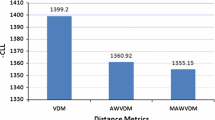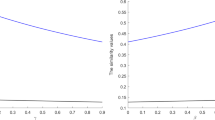Abstract
Due to its simplicity, efficiency and efficacy, value difference metric (VDM) has continued to perform well against more sophisticated newcomers and thus has remained of great interest to the distance metric learning community. Of numerous approaches to improving VDM by weakening its attribute independence assumption, attribute weighting has received less attention (only two attribute weighting schemes) but demonstrated remarkable class probability estimation performance. Among two existing attribute weighting schemes, one is non-symmetric and the other is symmetric. In this paper, we propose two simple improvements for setting attribute weights for use with VDM. One is the non-symmetric Kullback–Leibler divergence weighted value difference metric (KLD-VDM) and the other is the symmetric gain ratio weighted value difference metric (GR-VDM). We performed extensive evaluations on a large number of datasets and found that KLD-VDM and GR-VDM significantly outperform two existing attribute weighting schemes in terms of the negative conditional log likelihood and root relative squared error, yet at the same time maintain the computational simplicity and robustness that characterize VDM.
Similar content being viewed by others
References
Alcalá-Fdez J, Fernandez A, Luengo J, Derrac J, García S, Sánchez L, Herrera F (2011) KEEL data-mining software tool: data set repository, integration of algorithms and experimental analysis framework. J Mult Valued Log Soft Comput 17(2–3):255–287
Bian W, Tao D (2012) Constrained empirical risk minimization framework for distance metric learning. IEEE Trans Neural Netw Learn Syst 23(8):1194–1205
Blanzieri E, Ricci F (1999) Probability based metrics for nearest neighbor classification and case-based reasoning. In: Proceedings of the 3rd International conference on case-based reasoning. Springer, pp 14–28
Cost S, Salzberg S (1993) A weighted nearest neighbor algorithm for learning with symbolic features. Mach Learn 10:57–78
Davis JV, Kulis B, Jain P, Sra S, Dhillon IS (2007) Information-theoretic metric learning. In: Proceedings of the 24th conference on machine learning. ACM Press, Corvalis, pp 209–216
Demsar J (2006) Statistical comparisons of classifiers over multiple data sets. J Mach Learn Res 7:1–30
Domeniconi C, Gunopulos D (2001) Adaptive nearest neighbor classification using support vector machines. In: Advances in neural information processing systems 14. MIT Press, Cambridge, pp 665–672
Domeniconi C, Peng J, Gunopulos D (2000) Adaptive metric nearest-neighbor classification. In: Proceedings of the IEEE conference on computer vision and pattern recognition. IEEE, Hilton Head, p 1517
Domingos P, Pazzani M (1997) On the optimality of the simple Bayesian classifier under zero-one loss. Mach Learn 29:103–130
Elkan C (2001) The foundations of cost-sensitive learning. In: Proceedings of the 17th international joint conference on artificial intelligence, pp 973–978
Frank A, Asuncion A (2010) UCI machine learning repository. University of California, Irvine
Garcia S, Herrera F (2008) An extension on statistical comparisons of classifiers over multiple data sets for all pairwise comparisons. J Mach Learn Res 9:2677–2694
Grossman D, Domingos P (2004) Learning Bayesian network classifiers by maximizing conditional likelihood. In: Proceedings of the 21st international conference on machine learning. ACM, pp 361–368
Guo Y, Greiner R (2005) Discriminative model selection for belief net structures. In: Proceedings of the 12th national conference on artificial intelligence. AAAI, pp 770–776
Hall M (2007) A decision tree-based attribute weighting filter for naive Bayes. Knowl Based Syst 20:120–126
Hall MA (2000) Correlation-based feature selection for discrete and numeric class machine learning. In: Proceedings of the 17th international conference on machine learning. Morgan Kaufmann, Stanford, pp 359–366
Hastie T, Tibshirani R (1996) Discriminant adaptive nearest neighbor classification. IEEE Trans Pattern Anal Mach Intell 18(6):607–616
Hu JH, Zhan DC, Wu X, Jiang Y, Zhou ZH (2015) Pairwised specific distance learning from physical linkages. ACM Trans Knowl Discov Data 9(3):20
Jiang L, Li C (2013) An augmented value difference measure. Pattern Recognit Lett 34(10):1169–1174
Jiang L, Li C, Zhang H, Cai Z (2014) A novel distance function: frequency difference metric. Int J Pattern Recognit Artif Intell 28(2):1451002
Kasif S, Salzberg S, Waltz D, Rachlin J, Aha D (1998) A probabilistic framework for memory-based reasoning. Artif Intell 104:287–311
Kira K, Rendell L (1992) A practical approach to feature selection. In: Proceedings of the 9th international conference on machine learning. Morgan Kaufman, Aberdeen, pp 249–256
Kullback S, Leibler RA (1951) On information and sufficiency. Ann Math Stat 22(1):79–86
Lee CH, Gutierrez F, Dou D (2011) Calculating feature weights in naive Bayes with Kullback–Leibler measure. In: Proceedings of the 11th IEEE international conference on data mining. IEEE, Vancouver, pp 1146-1151
Li C, Jiang L, Li H (2014) Local value difference metric. Pattern Recognit Lett 49:62–68
Li C, Jiang L, Li H (2014) Naive Bayes for value difference metric. Front Comput Sci 8(2):255–264
Li C, Jiang L, Li H, Wu J, Zhang P (2017) Toward value difference metric with attribute weighting. Knowl Inf Syst 50(3):795–825
Li C, Li H (2011) One dependence value difference metric. Knowl Based Syst 24(5):589–594
Li C, Li H (2012) A modified short and fukunaga metric based on the attribute independence assumption. Pattern Recognit Lett 33(9):1213–1218
Li C, Li H (2013) Selective value difference metric. J Comput 8(9):2232–2238
Mitchell TM (1997) Machine learning, 1st edn. McGraw-Hill, New York City
Myles JP, Hand DJ (1990) The multi-class metric problem in nearest neighbour discrimination rules. Pattern Recognit 23(11):1291–1297
Nadeau C, Bengio Y (2003) Inference for the generalization error. Mach Learn 52(3):239–281
Qiu C, Jiang L, Li C (2015) Not always simple classification: learning superparent for class probability estimation. Expert Syst Appl 42(13):5433–5440
Quinlan JR (1986) Induction of decision trees. Mach Learn 1:81–106
Quinlan JR (1993) C4.5: programs for machine learning, 1st edn. Morgan Kaufmann, San Mateo
Robnik-Sikonja M, Kononenko I (2003) Theoretical and empirical analysis of relieff and rrelieff. Mach Learn 53(1–2):23–69
Saar-Tsechansky M, Provost F (2004) Active sampling for class probability estimation and ranking. Mach Learn 54:153–178
Sangineto E (2013) Pose and expression independent facial landmark localization using dense-surf and the Hausdorff distance. IEEE Trans Pattern Anal Mach Intell 35(3):624–638
Short RD, Fukunaga K (1981) The optimal distance measure for nearest neighbour classification. IEEE Trans Inf Theory 27:622–627
Stanfill C, Waltz D (1986) Toward memory-based reasoning. Commun ACM 29:1213–1228
Weinberger KQ, Blitzer JC, Saul LK (2006) Distance metric learning for large margin nearest neighbor classification. Adv Neural Inf Process Syst 18:1473–1480
Wilson DR, Martinez TR (1997) Improved heterogeneous distance functions. J Artif Intell Res 6:1–34
Witten IH, Frank E, Hall MA (2011) Data mining: practical machine learning tools and techniques, 3rd edn. Morgan Kaufmann, San Francisco
Yang L (2006) Distance metric learning: a comprehensive survey. Technical report, Department of Computer Science and Engineering, Michigan State University
Zaidi NA, Cerquides J, Carman MJ, Webb GI (2013) Alleviating naive Bayes attribute independence assumption by attribute weighting. J Mach Learn Res 14:1947–1988
Acknowledgements
The work was partially supported by the National Natural Science Foundation of China (U1711267), the Program for New Century Excellent Talents in University (NCET-12-0953), the Chenguang Program of Science and Technology of Wuhan (2015070404010202), and the Open Research Project of Hubei Key Laboratory of Intelligent Geo-Information Processing (KLIGIP201601).
Author information
Authors and Affiliations
Corresponding author
Rights and permissions
About this article
Cite this article
Jiang, L., Li, C. Two improved attribute weighting schemes for value difference metric. Knowl Inf Syst 60, 949–970 (2019). https://doi.org/10.1007/s10115-018-1229-3
Received:
Revised:
Accepted:
Published:
Issue Date:
DOI: https://doi.org/10.1007/s10115-018-1229-3




